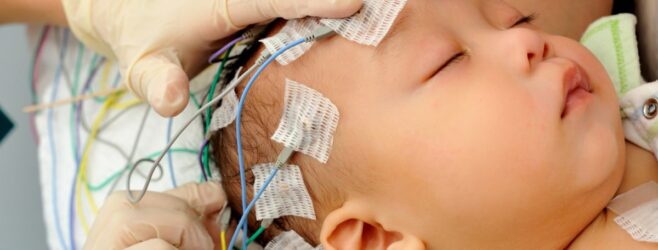A June 2025 study from Université de Montréal found that using EEG and optical neuromonitoring together can help doctors predict the severity of brain damage in newborns who suffered a lack of oxygen at birth.
These babies are often treated with therapeutic hypothermia (body cooling), but traditional brain scans like MRIs usually aren’t done until about 5 days after birth. By contrast, this new bedside method allows doctors to assess brain injury as early as day 2, without needing to move fragile newborns.
The combination of EEG, which tracks brain activity, and NIRS, which measures oxygen use in the brain, helped doctors tell whether the baby’s MRI would show mild, moderate, or severe brain damage.
This faster approach could help care teams tailor treatments earlier and more safely, especially for babies with moderate injuries that are harder to detect in the first few days of life. If your child experienced a brain injury at birth, legal help may be available.
Get a free case review right now to see if we can help you pursue compensation for your child’s care.
About the Brain Damage During Birth Diagnosis Study
The study monitored 52 newborns with hypoxic-ischemic encephalopathy (HIE), or anoxic brain damage at birth, who were receiving therapeutic hypothermia in the neonatal intensive care unit at CHU Sainte-Justine.
Researchers combined electroencephalography (EEG) and near-infrared spectroscopy (NIRS) to assess brain activity and oxygen use during the first 2 days of treatment. This allowed them to predict the severity of brain injury several days earlier than traditional imaging methods. These first days are critical in treating newborn brain damage.
Key elements of the study included:
- Monitoring began within the first 2 days of hypothermia treatment
- EEG measured brain activity patterns and pauses
- NIRS measured how the brain was using oxygen and producing energy
- Infants were categorized by predicted injury severity: normal/mild, moderate, or severe
- MRI scans at day 5 were used to confirm the early predictions
This noninvasive, bedside method provided an earlier and more accessible way to get a clearer picture of how serious the brain injury at birth was, days sooner than a typical MRI.
The Combination of EEG & NIRS
Researchers used two noninvasive technologies during the first 2 days of treatment to evaluate brain function and oxygen use:
- Electroencephalography: Recorded the brain’s electrical activity to detect abnormal patterns or signs of reduced brain function
- Near-infrared spectroscopy: Measured how the brain was using oxygen, providing insight into blood flow and energy use
By combining these technologies, the research team was able to predict the likely severity of each infant’s brain injury well before traditional MRI scans, which typically happen around day 5.
This earlier, bedside approach offered a faster and safer way to assess brain damage in medically fragile newborns, potentially leading to earlier interventions and better outcomes.
Early signs of brain damage at birth may include seizures, low muscle tone, poor feeding, and difficulty breathing. While these symptoms can be easy to miss, they may point to a more serious underlying injury like HIE.
Fast Answers After Birth Injury Can Make a Difference
Understanding the severity of a newborn’s brain injury sooner can help families understand what their child might face in the days and years ahead — whether that means planning for specialized care, seeking support services, or simply having time to process the situation emotionally.
Early answers can help families:
- Access support services and financial resources sooner
- Ease the emotional toll of waiting for a delayed MRI
- Gain reassurance in cases with less severe injury
- Make informed decisions when the outcome is more serious
- Prepare emotionally and practically for the road ahead
- Start planning for specialized care, therapies, or interventions
“In neonatal intensive care, earlier intervention is always better,” explains Rasheda Chowdhury, lead author of the study.
In cases where a baby suffers a brain injury due to a lack of oxygen at birth, one of the key legal questions is whether the medical team acted quickly and appropriately during labor, delivery, and immediately after birth.
The combination of EEG and NIRS monitoring may help show how early signs of injury appeared after birth.
That information could be useful in identifying whether delays in care, failure to monitor fetal distress, or other medical errors may have contributed to the injury.
What the Study Found: Key Takeaways
The study found that combining EEG and NIRS allowed doctors to accurately predict the severity of brain injury in newborns with HIE as early as the second day of therapeutic hypothermia.
This dual approach helped health care providers tell how serious a baby’s brain injury might be. Standard MRIs are usually done around day 5, so this gave answers much earlier.
Key results included:
- Early, accurate predictions: The combined EEG and NIRS method correctly predicted how much brain damage would appear on MRI.
- Improved detection of moderate injuries: This approach was especially effective in spotting moderate brain damage, which can be harder to detect in the first few days of life.
- Noninvasive and bedside-based: Both tools were used safely at the bedside, avoiding the risks of moving medically fragile newborns and helping reduce delays.
These results suggest that this dual-monitoring strategy could become a powerful tool in neonatal intensive care, helping guide treatment decisions and giving families access to crucial information sooner.
Get Help From a Brain Damage Birth Injury Lawyer
If your baby suffered brain damage, like HIE, or another injury at birth due to medical malpractice, your family may be able to take legal action and pursue compensation that can help with their care.
Sadly, some birth injuries happen because of rushed decisions or failure to respond to clear warning signs.
Birth injury lawyers can help:
- Determine if medical malpractice was involved
- If a doctor, hospital, or health care provider may be to blame
- Explain your legal rights and options
- Pursue compensation on your behalf
Get a free case review now to find out if you may be eligible to take action over your child’s injury. It costs nothing to pursue compensation.




